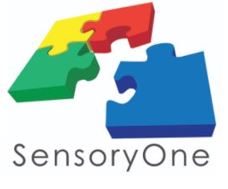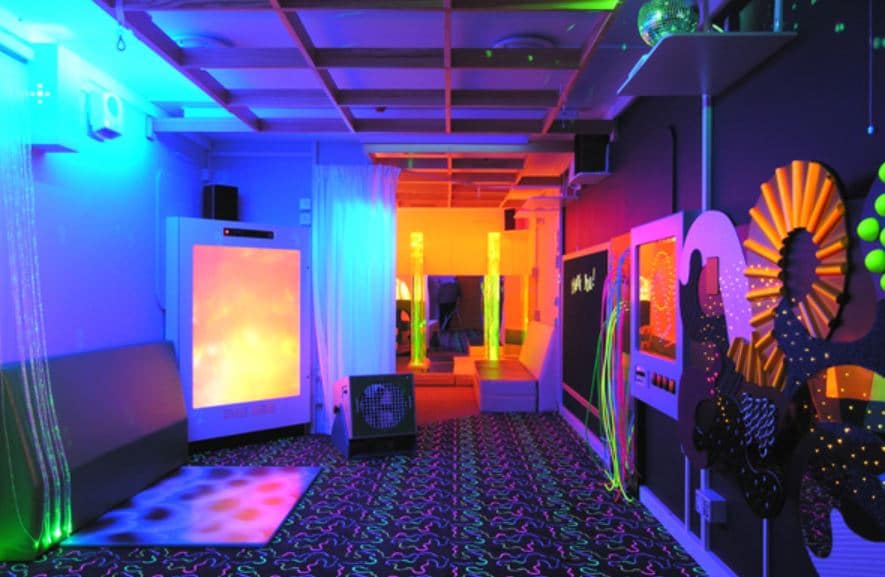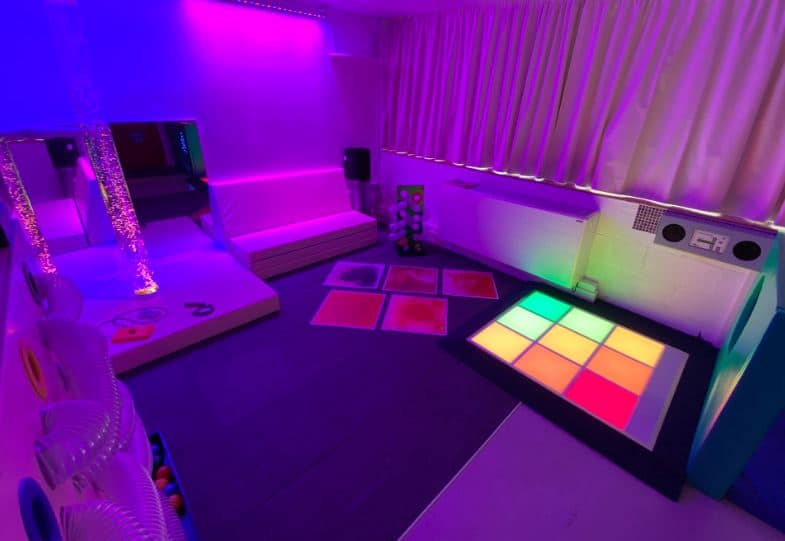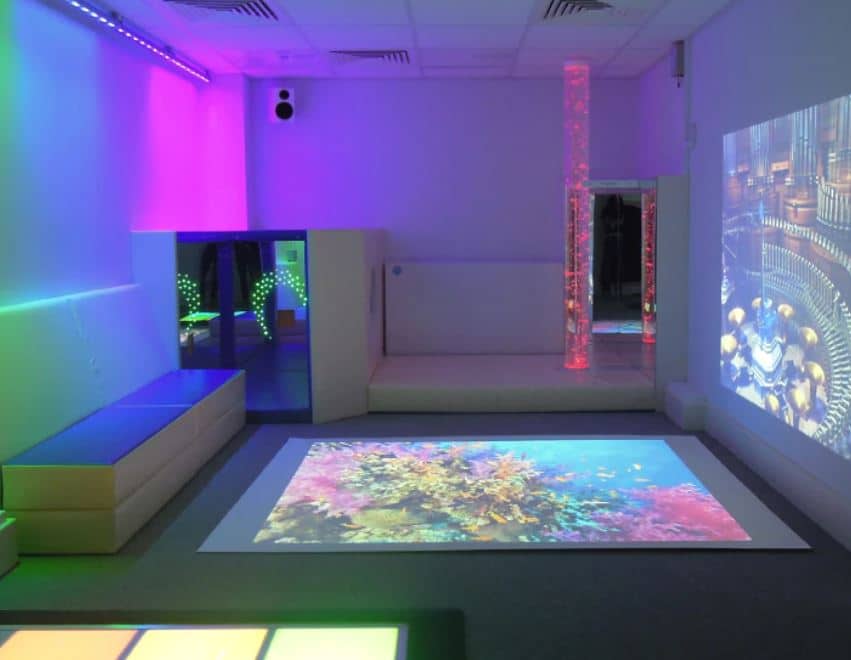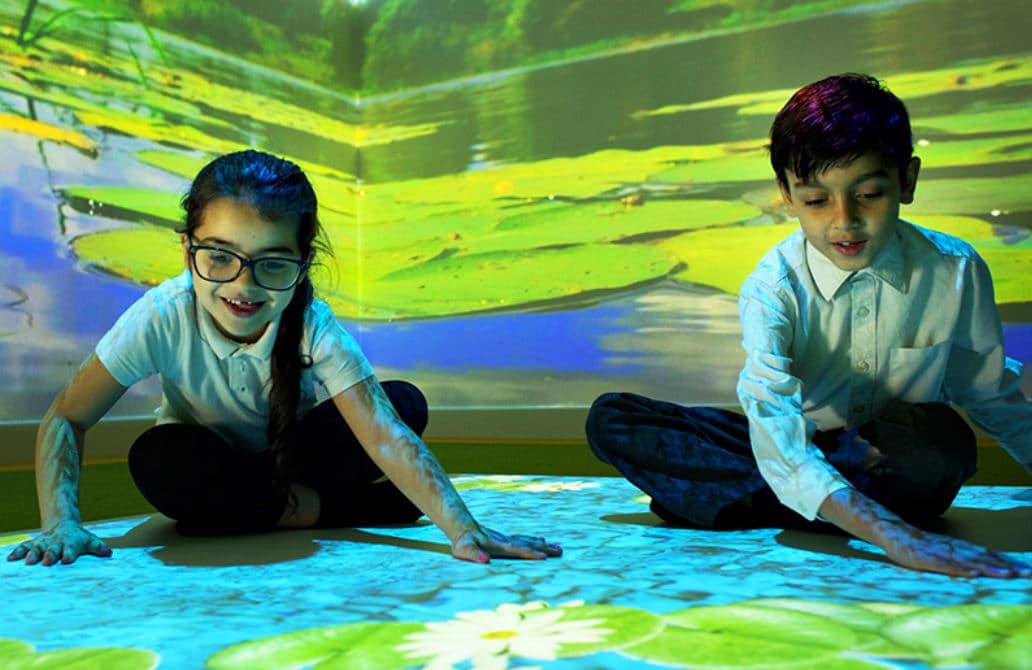Sensory Room Environment in Children’s Hospital
Continue readingA Time Out in a Sensory Space is Helpful & Effective for Children
For Educators & Parents, Sensory Spaces are Invaluable and Supportive for Kids
Creating a sensory space in a home or a school is growing trend, and has many benefits for both students and educators. Dedicating a space or a room to the sensory needs of students can help educators create the most beneficial learning environment for all of their students. It is not uncommon for educators to have a student that may need an adjustment in their attitude or surroundings, so the ability to offer them a time out in a sensory space can help them take time to calm down, while allowing teachers to make a non-punitive removal from the classroom.
[Time outs] are recommended by most pediatricians as a way to curb negative behaviors ranging from talking back to physical aggression. Research indicates that when used properly — along with other techniques that balance nurture and structure — time outs are effective and do not cause harm.
Child Mind Institute “Are Timeouts Harmful for Children“
One of the arguments (dismissed by most child psychologists) against timeouts is that it isolates children. As noted above, when used properly, they’re effective. However, time outs in sensory spaces contribute to positive behavours and outcomes. It enhances the child/student’s experience and aides in calming behaviour and aggression.
Sensory space in a school can have a calming effect
Although the goal of a classroom is to foster inclusion and acceptance, there are times when a child may need to be removed due to attitude or behaviour issues. However, punishing this behaviour can often lead to a child acting out further, whether out of anger or confusion. Having an on-site sensory space can present the teacher with an opportunity to give the student space to calm down on their own, without the pressure of their classmates nearby. Often removing a child from a situation and placing them in a calming space will have a more positive result than punishing them would.
A sensory space that is filled with calming features can help these students naturally release their anger and anxiety, leading to a calmer interaction when they return. Features like dim lights, comfortable chairs, quiet music, and low stimulation toys can help a child improve their reactions and behavior naturally.
Beneficial for everyone involved
When a child is being disruptive in class, they can be a distraction to everyone in the room. In these situations, the most beneficial option for everyone is to remove the disruptive child from the space so that the remaining students can continue on with their day. However, simply sending the child into the hallway or down to the office isn’t likely to heal the issue that led to their disruptions in the first place. A sensory space can offer children a dedicated and quiet place to take a time out and reflect on the situation, without pushing for an immediate resolution. This option is beneficial for everyone involved for many reasons.
- Helps relieve the teacher during a stressful situation
- Offers the removed student the opportunity to calm down and distance from the situation in their own unique way
- Provides a place to retreat to when the school setting becomes triggering or stressful
- Gives teachers a safe space to interact with and learn about their unique students
- Allows providers to understand and learn about the needs of individual students, and cultivate a space that helps them feel safe
- Allows the rest of the class to be separated from disruptive behaviour
- Sometimes participants need space from each other, which a sensory room can provide
- Kids with sensory processing and learning disorders like ADHD and Autism
A sensory space doesn’t have to be fancy or complicated
When you start looking into the features to include in a sensory space there are nearly endless options of activities, toys and tools. However, a sensory space doesn’t have to be expensive or fancy. Simply providing a space for students to retreat to when they need it can make the difference for many kids. Including a projector or virtual reality tech can be a fun and helpful addition, but often starting simple with good lighting, a variety of books, interactive toys, and calming sounds with comfortable places to sit is a great way to go.
A sensory space is not a punishment
Regardless of why a child is encouraged or led to visit a sensory space, it is essential that they do not come to see it as a punishment. Many children process things in unique ways, so a sensory space is a great way to honour their uniqueness while also removing them from a triggering situation. This removal helps the remaining children feel safe and cared for, while also offering the disruptive student a break without being punished.
Many options for creating a great sensory space
Whether you’re able to dedicate an entire room or are just looking to furnish a small space or mobile cart, there are no rules for how to create a sensory space. Teachers can band together to plan and fill the space with tools they think would help, or they can contact a professional to help them create the perfect space. Sensory room concierge services are designed to evaluate the needs of everyone involved and advise or curate the tools that will have the biggest impact. Teachers spend so much of their time looking out for the best of their students, and creating a great sensory space is another tool that will help them continue to do that.
Take advantage of SensoryOne’s ‘concierge service’
| OM Interactive’s motion-activated technology is packed full of features that make this interactive device all the more engaging, beneficial and easy to use for seniors, including long-term-care residents and community program participants. To help you better take advantage of all of the system’s compelling features, SensoryOne now offers what we call our “concierge service.” It’s our way of helping you to personalize this technology and package its programming to suit your needs, making no additional work for your already time-crunched staff. While other systems come with a limited number of applications, OMI’s groundbreaking and award-winning technology (including the most popular Mobii Magic Surface model) offers hundreds of applications, ranging from nature interactions to physical agility games, mental stimulation activities to imaginative music content. Also on offer is a “Care Suite” targeted to older adults, including those with dementia. The choice is huge, but the system offers the ability to sift through the applications to create different “folders” of pre-set programming that may be targeted to individuals or groups of users, or types of activities. For instance, you could create a folder full of popular “splat” games that are fun, engaging and encourage strong social connections. Or maybe you want to trigger memories for a particular user. You could create a folder including photos of that person’s family and friends, fellow residents and staff, special celebrations attended and familiar local landmarks. Such therapeutic content brings many positive emotional benefits. Interested in creating such content but don’t have the time to devote to putting it together? That’s where we come in. With the concierge service, when you purchase an OMI interactive, motion-activated projection system, we’ll do the work for you. Just tell us what themes you want, what kind of material you’d like to include, and how long you want the contents of a folder to run, and we’ll pick and put in the right applications for you. Want to make a folder with special meaning? Send us the photos, videos, music and other content you want included, and we’ll have it ready for you in no time. As easy as this technology is to use, it can be made even easier. In fact, it can actually operate on autoplay, meaning there is no need for employees, who are already facing so many overwhelming challenges, to be on hand to run a session. No work for you or your staff, but lots of beneficial play for users! And you can be sure that those who interact with OMI’s motion-activated systems will be transported on dynamic, captivating, stimulating and broadening journeys of discovery. |
Top Sensory Room Ideas for Calming Children
Sensory spaces can serve a variety of different purposes depending on who is visiting it and what they are hoping to get from the experience. Taking some time to consider the goals of your sensory space will help you decide the best way to set it up for maximum effectiveness. The lighting, sounds, furniture, toys and equipment you include will help guide visitors towards the mood you are trying to create. A calming sensory space will help kids in a number of different ways, and considering the needs of the children that will use it will help you create the perfect space for them.
A calming sensory room benefits many struggling children
Kids who struggle with a number of different issues can benefit from spending time in a calming sensory space. A space that reduces stimulation and stress can help kids to step away from stressors and experience a calmer attitude. Those who struggle with autism, ADHD, behavioural issues, anxiety, vision issues and other sensory processing issues will all benefit from having a dedicated calm space in which to spend time.
Creating a calming sensory space
Filling your area with things that help induce a calm and quiet atmosphere is the best way to ensure kids will benefit from this style of sensory space. The lighting, sounds, equipment and furniture you choose to include will all play a significant role in how kids interact with their surroundings and what they take away from their time there.
Ideal lighting for a calming space
When creating a calming sensory space, you want to use lighting that isn’t too harsh or bright. Children looking for a calming space will benefit from lighting with yellow tones and the ability to be dimmed. Dimmable lights allow the space to be adjusted to the needs of the child using it, so that their experience can be very personal to them. You can also use Christmas or string lights, battery powered candles, glow sticks, lava lamps and bubble tubes to set the mood for your calming sensory room.
Best equipment to encourage calmness
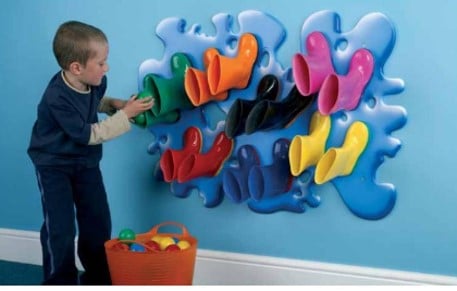
When creating your sensory space, the list of toys and equipment that you can include is endless. While some spaces are designed to help stimulate a child, others are intended to help calm them. The equipment that you include will play a significant role in what kind of space is created. Some ideas of items to bring into your calming sensory space include:
- Bubble tubes, walls or lamps
- An hourglass or Zen sand garden
- Fidget toys
- A tactile mat, wall or carpet
- Stress balls
- Magic sand
- Expanding Ball
- Silly putty, play-do or modelling clay
- Stuffed animals
- Weighted blanket
- Colouring books
- An interactive projector system
Calm-inducing furniture
While a sensory space created for a high-energy child might focus on using furniture that can allow movement, like trampolines and climbing ropes, a calming sensory space should include furniture that encourages relaxation. Items like beanbag chairs, floor pillows, hammocks and anything that can encourage kids to relax and unwind are perfect for a calming sensory space.
Best sounds for a calming sensory space
The background sounds in a sensory space can also play a role in the mood that’s created. A calming space should feature calm sounds to help children immerse in the experience. A sound machine can help you find the right sounds for your space. Tracks that include the sound of moving water like rain, bubbling streams, waves hitting the shore or a waterfall are typically very relaxing and calming. Soft instrumental music is also often quite calming. However, you’ll want to evaluate your particular child or children before committing to something as their interests and needs will vary.
How to create a calming environment
Even if all you have is a small corner of a room in which to create a sensory space, there are many things that you can do in order to maximize its effect on children. Combining the right lighting, sounds, toys, equipment and furniture is the best way to create a space that exudes calmness. Once you have figured out where your sensory space will be, you can start deciding what will go into it. Start by choosing a comfy seat and mood lighting, then add a few toys or activities that can help create a calm atmosphere.
A sensory space can be simple to implement
Even if you’re dealing with fairly restricted space, you can create a mobile sensory cart or bin that can go wherever the child does, with small items that are portable. A sensory space does not need to take up an entire room or be anything over the top in order to be effective. Kids will benefit from having even a small area dedicated to providing tools to help them experience calmness. The sights, sounds, lighting and equipment you choose will help them to get the most out of a calming sensory space, regardless of where and how big it is.
Gaming Sensory Rooms with Interactive Projection for High Child Engagement
When building a sensory room for children there are a wide variety of items that you can include that will help engage, relax, destress and stimulate. One such tool is an interactive sensory projector system. This modern technology can help children interact with and learn from their environment through exploration, movement and collaboration. The rewards that children of all ages, abilities and sensory needs can experience from using a gaming sensory room will stick with them for the rest of their lives.
At SensoryOne, we offer OM Interactive sensory projector systems across North America. Our experts will review applications and games suitable for your intended group – ideal for children and elderly groups.
Many benefits of a sensory projector system
Sensory projectors are a relatively new technology that blend visual cues with physical engagement in order to create a beneficial sensory environment that is catered towards the individuals looking to use it.
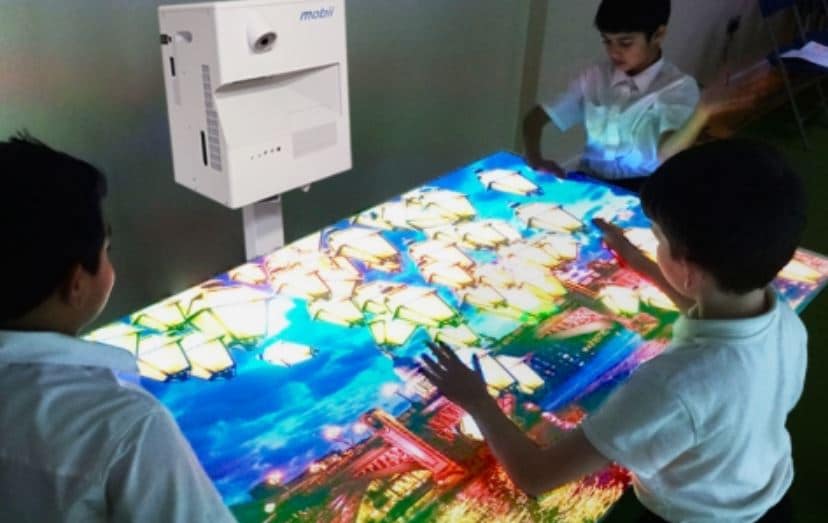
Stimulate the brain and body
The images, programs and games projected on an interactive projector encourage children to both physically and mentally engage with the experience. With a responsive system that responds to all movements big and small, kids will quickly learn the effect that their participation can have on their surroundings.
Encourages learning
A sensory projector system makes learning fun, even for children who struggle with learning delays, disabilities and differences.
Improves socialization
Projector systems encourage children to work together in order to engage with whatever image is being displayed. Multiplayer games and team challenges encourage kids to socialize and play together to reach a common goal.
Encourages both independent and collaborative play
The interesting and immersive games and activities can be catered to both individuals and groups of kids.
Geared towards engaging atypical and special needs children
With a variety of different activities and programs available, sensory room leaders can cater the offerings to the children they would like to entertain and engage.
Benefits mental and emotional health
Having a space in which they feel comfortable and accepted can help children to gain a sense of belonging and improved self-worth. This can lead to improved moods and increased emotional stability.
Benefits of creating a gaming sensory room for high child engagement
A gaming sensory room often involves using an interactive projector to create a stimulating and immersive experience that will have many positive effects on the day to day lives of those using it. A gaming sensory room has many benefits for its visitors including:
- Stimulates the imagination
- Encourages children of various abilities and backgrounds to work and play together
- Calls for active participation
- Promotes physical and mental development
- Improves language and communication skills
- Provides engaging and stimulating content
- Promotes the development of problem-solving and collaboration skills
- Allows children to control their immediate environment and experience instant rewards
- Offers opportunities for socialization that are specific to each child’s abilities
- Improves gross and fine motor skills
- Encourages families to play together and get to know each others needs, without pressure
- Can offer both calming or stimulating activities
OMi projection systems are a winning choice
The OMi brand of projection system offers a variety of options that are easily adapted to the space being used, and the people looking to use it. The incredibly responsive projections are perfect for both groups and individuals of all ages and abilities. With built-in applications and themed suites of games and programs, the OMi system is an excellent option for those looking to build a sensory gaming room.
Depending on the area you are looking to outfit with a projection system, you have a few options to choose from:
OmiVista
Available in both mounted and portable models, the omiVista projects images onto horizontal surfaces like floors and tables. Choose the Install Interactive model if you intend to mount the projector to the ceiling and won’t be moving it around. The Mobii Magic Surface is the most versatile model available as it can be moved around as needed and can even project onto small spaces like beds and tray tables.
OmiReflex
The omiReflex is also available in mounted and portable models, however this version projects onto vertical surfaces like walls and drop-down screens. This model can allow users to upload their own sounds, images and videos which brings in another level of interaction for the user. Another interesting benefit to the mobile version of the Reflex, the Mobile Interactive model, is that it can connect to game consoles like Apple TV, Nintendo Wii and Xbox Kinect.
OmiSky
As you may guess from the name, the omiSky projects onto the ceiling. Installed on a wall, this model projects a mirror image of the users on the ground onto the ceiling, while an app projects an image alongside them. Kids are then able to interact with the projection while looking up from a comfortable seated or laying position.
An interactive gaming room is the ultimate sensory tool
For those children who will benefit from using a sensory room, an interactive gaming room is the next level of support. A projection system can help both children and adults overcome many challenges, while engaging in their world in a manner that they feel comfortable with.

